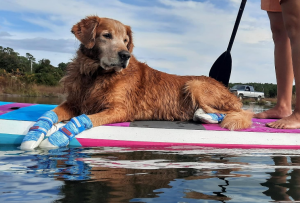When it comes to boat hunting waterfowl, a well-trained hunting dog can be an indispensable tool for retrieving downed birds. However, boat space is limited, and safely handling an excited dog takes consideration. In this article, we provide handy tips for managing your dog while hunting flooded timber, marshes, or open water from a boat.
Positional Safety for Hunting Dogs and Hunters
The safest position for two duck hunters in a boat is with one seated in the stern, controlling the dog, while the other shoots from the bow. This allows both hunters to freely swing and shoot without risk of accidentally striking the dog.
The dog should be positioned sitting or lying down on the floor of the boat between or just in front of the bench seats. Having them sit avoids obstructing the hunters’ shots. Use short verbal commands like “hup” for sitting and “kennel” for lying down calmly. A dog blind like those below can provide a defined space for your dog as well.
Once birds start falling, unleash your dog to maximize their movement for efficient retrieval. Just be mindful of their position if you must continue shooting at at approaching birds.
Essential Training for Boat Hunting Dogs
Any dog you plan to hunt over water from a boat requires thorough obedience training both on land and water. This keeps them under control, keeping all parties safe. Key training commands to master include:
- “Wait” prevents dogs from leaping out too early at incoming birds
- “Leave it” stops them from chasing birds out of range
- “Here” calls them back to the boat with any retrieved birds
- “Kennel”: Gets them settled down in a stationary spot on the boat floor
Always get young dogs acclimated to boats early on to avoid issues like seasickness. Give plenty of praise and treats for good behaviour in the boat and focused obedience. This solid foundation is essential for an enjoyable hunt.
Taking Your Hunting Dog’s Training to the Next Level
While basic obedience training is crucial for all hunting dogs, mastering advanced skills can make your four-legged partner even more effective in the field. Implementing advanced training techniques sets them up to excel during waterfowl or upland hunts from boats and flooded terrain.
In this blog, we’ll highlight expert-level commands and methods to further sharpen your hunting dog’s abilities for maximum performance.
Advancing Water Skills
For a dog succeeding at duck hunting, precise water entry and exit points are vital to efficiently retrieve downed birds. Here are two useful techniques:
Casting: Teach directional commands, guiding them to precise entry spots. For example, shouting “Back!” would cue them to jump in behind the boat. Whistle sequences can also direct their angle of entry. Mastering casting ensures they don’t disturb potential incoming birds.
Shore-Exit Training: Condition them to exit at the exact landing spot you indicate to deliver birds to hand. This prevents them from shaking water and grass onto the birds once they are they are aboard. Correctly done, they’ll swim directly to shore, shake off up the bank then briskly deliver to your hand.
Enhancing Marking Abilities
A dog that struggles to mark the precise landing point of falling birds will waste time meandering. Advanced methods boost marking accuracy:
- Hand signals: pointing, arm waves, and shotgun gestures all help guide your dog’s vision towards the bird’s descent zone. Associate verbal marking cues like “There!” or “Mark it!” while directing their line of sight.
- Launcher training: mastering marked retrieves from shotguns, hand throwers, or launching machines dials in marking precision.
- Delayed marking: After watching the bird’s descent, briefly hide or turn them before releasing them to simulate real hunting scenarios when birds drop in pockets.
- Long-range marks: practice on trajectories over 100+ yards to sharpen long-distance marking aptitude. Use shoreline points, islands, or horizon backgrounds as visual anchors.
Correcting Common Issues
As you advance training, also focus on correcting any weak areas holding your dog back:
- Poor recall: failproof come commands are non-negotiable. Consistently reinforce recalls using high-value treats, electronic collars as backup, and never calling when you cannot enforce the command.
- Leash pulling: Continue heel training on walks using harnesses, proper positioning, and behaviour corrections until they walk attentively without straining the lead.
- Jumping/barking: Squash overexcitement sets strict expectations for calm behaviour in vehicles, at launch points, and when spotting incoming birds.
The goal is to have a finished, polished hunter that precisely marks birds, obeys initial handling cues, delivers to hand, heels off-lead, and waits calmly to redeploy. Mastering these advanced skills separates capable dogs from truly phenomenal ones.
Upping Difficulty With Simulated Hunts
Once advanced yardwork skills click, simulate actual hunting scenarios. Enlist a helper to launch varied trajectories of fake birds from layout blinds, pits, or makeshift hunting setups. Position yourself and your dog away, or even out of sight, from the falls. Then cue and handle them just as during an actual hunt.
Train on technical water setups using decoy spreads and natural cover that dogs must bust through. Throw in diversion birds or misfires to test steadiness and marking focus. Mix up singles and multiple bird setups. The key is realistic, random chaos that sharpens their decision making. It’ll have them primed for the real deal opening day.
Consider Pro Training to Upskill
For highly polished hunting dogs, enlisting the services of a professional trainer can provide an added edge. Reputable waterfowl or upland pro trainers have extensive backgrounds fine-tuning the nuances that set great hunting dogs apart. They reinforce fundamentals with an expert eye and can correct lingering flaws using proven techniques.
Paying for a full training programme or even a refresher bootcamp can be a worthy long-term investment. Just be sure to clearly communicate your goals and continue reinforcing the new skills taught by the trainer. This combination best sets your dog up for success in the field.
Put in the work to advance your hunting dog’s skills, and it will pay off tenfold this season. Their potential is limited only by the effort you dedicate to honing it. Employ these tips for expert level handling, and they’ll be finished hunters in no time!
Top Gear for Boat Hunting with Dogs
Having the proper dog gear aboard helps handling proceed smoothly and safely during hunts. Recommended items include:
- Hunting Dog Life Vest – Provides buoyancy and visibility over cold water
- Neoprene Dog Boots – Protect paws from sharp ice and cold while retrieving
- Dog Blind/Bed – Defines their space and keeps them comfortable in the boat
- Quick Release Collar – Essential if they tangle on debris and need to break free
- Water Bowl – Let them rehydrate as needed between retrieves
Top Products on Amazon
Here are some excellent, highly rated products on Amazon to consider that meet hunters’ needs when handling dogs from boats:





Following these positioning, training, and gear recommendations will lead to enjoyable, productive, and safe boat hunts with your trusted four legged companion. Check out the links above to shop for top rated products that enhance success this season.
Conclusion
Boat hunting over water with well-trained dogs can make for amazing hunting experiences. But safely handling excitable dogs in unstable water demands consideration of risks. Always position dogs low in the boat, away from the active shooter. Essential verbal obedience commands taught early create a controlled foundation. And the right protective and handling gear keeps dogs secure while hunting in flooded forests and marshes via boat. Implement these guidelines to ensure safe hunts for both you and your dog.















